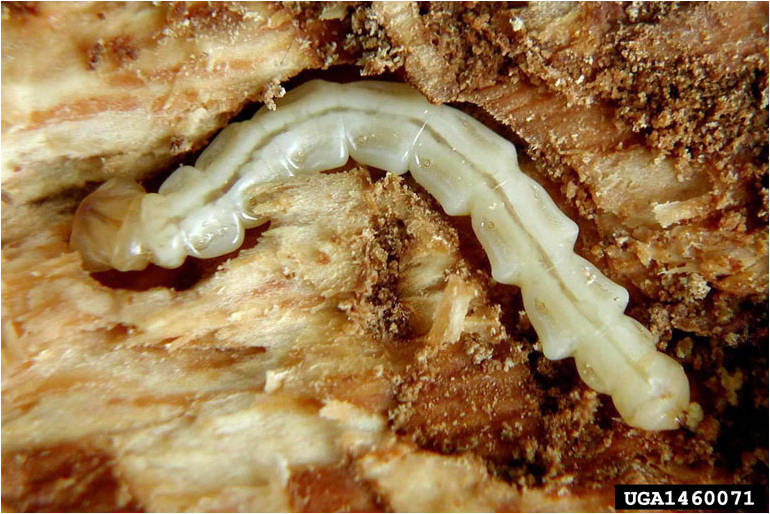Emerald Ash Borer Confirmed in Illinois
June 13, 2006
Illinois Department of Agriculture
 |
EAB larva, Purdue University |
GENEVA, Ill. – A destructive, non-native pest that feasts on ash trees has been detected in northern Illinois. The Illinois Department of Agriculture announced today that a beetle found in the yard of a Kane County home east of Lily Lake is an emerald ash borer (EAB).
"A coalition of local, state and federal agencies, including the USDA’s Animal and Plant Health Inspection Service, U.S. Forest Service and Illinois Department of Agriculture, has been preparing for this day the past two years," Agriculture Director Chuck Hartke said. "Now that the emerald ash borer has been confirmed within our borders, we’ll activate our response plan and begin the task of eradicating it. The first step is to conduct an extensive survey of ash trees in the area to determine the extent of damage. The findings will help establish boundaries for a quarantine that will stop the movement of potentially contaminated wood and nursery products out of the area and prevent the spread of this pest."
The emerald ash borer is a small, metallic-green beetle native to Asia. Its larvae burrow into the bark of ash trees, causing the trees to starve and eventually die. While the beetle does not pose any direct risk to public health, it does threaten the tree population. Since the emerald ash borer was first confirmed in the Midwest in the summer of 2002, more than 20 million ash trees are dead or dying.
"We’ve had tremendous success identifying invasive species through public awareness and education," Warren Goetsch, IDOA division manager of Natural Resources, said. "Nearly every sighting of the Asian Long-horned beetle in Chicago was reported by a citizen. With that kind of assistance here, I’m optimistic we can contain this pest and save ash trees."
The homeowner discovered the beetle and alerted the Animal and Plant Health Inspection Service’s Illinois field office, which sent the bug to its lab in Romulus, Mich., for identification and notified IDOA nursery inspectors.
Inspectors visited the residence in "The Windings" subdivision where the beetle was found and discovered several infested ash trees. They also canvassed the neighborhood and uncovered at least six additional infested trees within five-blocks of the residence, as well as evidence of an infestation in an adjacent subdivision to the north.
"The diversity of the landscaping in this neighborhood will help our eradication efforts," Goetsch added. "Only about 5 percent of the trees are ash varieties."
Inspectors have not determined how the beetle arrived in Illinois, but suspect it may have been transported here in contaminated firewood from a quarantined area in Michigan. Michigan and Illinois are two of the five states where EAB infestations have been confirmed. The others are Indiana, Ohio and Maryland.
The emerald ash borer typically moves only short distances by flying, but can survive long distances in transit on ash nursery stock, ash logs, branches and firewood. To avoid the accidental introduction of the beetle to new areas, people are advised to purchase only locally-grown nursery stock and locally-cut firewood.
The emerald ash borer is difficult to detect in newly-infested trees. Signs of infestation include the presence of metallic-green beetles about half the diameter of a penny on or around ash trees, thinning and yellowing leaves, D-shaped holes in the bark of the trunk or branches and shoots growing from the base of the tree. Anyone who suspects a tree has been infested is urged to first contact their county Extension office. The Illinois Department of Agriculture also will offer a toll-free hotline at 800-641-3934 for extension-confirmed infestations.
Options for treating infested trees are limited. In most instances, they must be removed. |